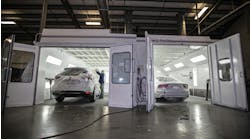Content brought to you by ABRN. To subscribe, click here.
What you will learn:
• Second only to labor, paint and material is arguably the largest category for which MSOs and other collision repairers manage and negotiate pricing.
• Paint and materials leave the shop in one of three ways: on a car, in a waste container, or in a box.
• Repairers must continue to review costs, determine appropriate rates, and persistently negotiate rates to achieve sales that offer a reasonable profit margin despite inflation.
We as MSO operators are in the best of times as well as the worst of times. Political polarization, cultural turmoil, costs rising at crazy rates, increased government regulation and intervention, staffing shortages, COVID, parts shortages, paint and material shortages, and technology changing so fast our heads are swimming. Yet most of our shops are filled with work and backlogged. The industry is reacting to cost increases as never before. Many consolidators are leading the charge with the most aggressive labor rate negotiations in decades, even to the point of sacrificing some DRPs and their referrals. They are bypassing the traditional $2 an hour periodic (every few years) increases we have experienced as long as I can recall and instead are seeking 10 to 20 percent or more. The negotiations are tough, painful, and slow, and yet they are moving at unprecedented rates and continue to move. Still, as shop operators we see that the rates are still not keeping up with the rising costs of labor, paint, material, energy costs, and frankly everything else we pay for.
Second only to labor, paint and material is arguably the largest category for which we manage and negotiate pricing.
Recent state of affairs
In recent years, even those with very low rates of inflation, paint companies generally have continued to raise retail prices annually. I’ve seen that occur at a typical rate of about six percent per year. Typically, they tell us the rate of increase is spread among their various products, though some specific products may be adjusted at higher or lower rates. If you are so inclined to truly understand the net effect, it is not a bad idea to perform a “before-and-after” comparison on the specific products you use to truly understand the net cost change for your company. At the very least, look at the costliest portion of your purchases, which is typically clearcoats, due to their cost and volume of usage.
In those years of higher energy costs, paint companies are often quick to point out that oil and other raw material increases have a dramatic effect on their costs and therefore justify pricing increases. Thankfully for us, repairers and paint companies, raw materials are typically purchased in large quantities and well in advance of usage, so raw material cost increases lag in time. I’ve heard from some companies that those raw materials are up 20 percent, giving us an idea of what to expect in the months and years to come.
The consolidation of shops has had a dramatic effect on paint companies. Due to their purchasing power and market share, they’ve been able to negotiate better discounts than other repairers. And over a period of time, other repairers gain an idea of the differences in discounts and negotiate better ones for themselves. And thus, the paint companies often increase pricing, aside from inflation, to maintain their margins. In the past, I would have encouraged shops to look at their own usage efficiencies and estimating practices to best maintain their paint and material margins, as there is more to be gained in those areas. But in today’s world, it has become increasingly important to, as best as one can, regularly get a feel for what competitive paint discount rates are and renegotiate with your supplier as appropriate. The situation is more fluid than in the past. (No pun intended!)
Current state of affairs
And now we are seeing paint cost increases of eight percent to 10 percent or more annually, with big increases on the horizon.
One can always look at changing paint brands, though comparisons are complicated. Testing and transitions can be painful and expensive. The same applies to other materials. I am fortunate to work for a company that emphasizes high quality work and products, often in a vehicle manufacturer certification program. Therefore, we simply utilize high-quality products and are less inclined to consider compromise. Still, it doesn’t hurt to look at alternatives, if for no other reason than understanding. If you have a good and trusted supplier, often they can “filter” the options and bring to your attention only the ones that are appropriate for your business model.
Once you’ve established the products of choice and best possible pricing, the product usage (efficiency) and sale become a mathematical equation to create profitability.
Efficient product usage
Assuming you work with a major paint company — and they are frankly all quite good in so many ways — they can typically help an MSO with very specific data on the usage of various paint and material products. They can help accumulate the data to help with paint cost per repair order, and per estimated paint hour, clearcoat costs, solvent costs, and more. Similarly, they can break it down to various material costs. And they usually have benchmarks of what better performers are achieving. Twenty groups are another source for such information.
I am a believer in managing by exception. In other words, if the data for a particular paint or material category is good, I probably won’t spend much time on it. Instead, I would focus on those areas that present greater opportunity for improvement. It helps to take a simplistic view on how the process works to help improve a category. For example, all paint products come into your shop then leave. They typically come in a cardboard box and are put in inventory on a shelf. They are then taken for use and end up leaving the shop. They only leave in one of three ways: on a car, in a waste container, or in a box. If your purchases are higher than benchmarks suggest they should be, look to find where the paint is going. Look to see if there are redos. If so, the excess paint is leaving on a car. If your waste costs are higher than benchmarks suggest, then the excess paint is leaving in a waste drum. The painter is most likely overmixing or is mixing more paint than is necessary for the job. Also make sure that excess mixed primers and clears are shared among painters to maximize usage. And if you can’t find any reason, then check to see if it is being stolen, thus leaving in a box.
Especially when challenged by our increased costs, it is useful to look at those items we may be “leaving on the table” in our estimates.
Paint and material sales
The old adage that there are only two ways to improve profits still applies. One is to reduce costs and two is to increase sales. If your paint and material bottom line is being hurt by inflation, these are still the tools at your disposal.
Our popular estimating systems leave a lot to be desired in terms of clarity and thoroughness. There are so many steps not included and thus often not utilized. And insurers very well understand that when paint labor hours are reduced, the cost of paint and material is typically reduced as well. Therefore, paint and material categories are often a target for audits and negotiation. Especially when challenged by our increased costs, it is useful to look at those items we may be “leaving on the table” in our estimates. These are “not-included” steps that we are performing but not charging for. Some of the most common include burn time, feather/block/prime, jambs, clearcoat caps, undersides, corrosion protection, hazardous waste disposal, tint, fasteners, and the many adhesives we use. There are many newer tools to assist, such as automated fastener cost retrieval systems and the 3M Collision Repair Materials Planner (CRiMP). It is wise to refer to the Crash Network/Collision Advice “Who pays for What?” data for ideas and to learn how frequently other repairers are getting paid for such items.
And of course, we as repairers must continue to review our costs, determine appropriate rates, and persistently negotiate rates to achieve sales that offer a reasonable profit margin despite inflation. In our unique industry, that is a huge challenge that can only be overcome with persistently creating understanding by those who pay us.





